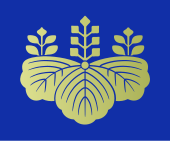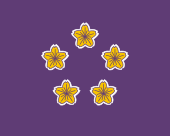Prime Minister of Japan
| Prime Minister of Japan | |

|
|
| Prime Minister's emblem | |

|
|
|
Go-Shichi no Kiri the coat of arms of the Prime Minister and his cabinet |
|

|
|
|
Standard of the Prime Minister since 1972 (slightly modified 2001) |
|
|
Acting Prime Minister Yoshihide Suga since September 16, 2020 |
|
| Official seat | Kantei in Nagatachō , Tokyo |
| Term of office | maximum 4 years (re-election possible) |
| Creation of the office | December 22, 1885 |
| position | Head of government |
| State authority | executive |
| Appointment by | Kokkai |
| Professional | Tennō |
| Chairman of | Naikaku |
| salutation | Excellence |
| Last choice | September 16, 2020 |
| website | www.kantei.go.jp |
The Japanese government , in German as prime minister or as prime minister is referred to since 1947 by the Parliament among the deputies of both chambers elected . In the event of a conflict between the upper and lower houses, the election in the lower house decides if a mediation in the mediation committee is unsuccessful. He is then used by the Tennō in the Shinninshiki . The prime minister is the chairman of the Japanese cabinet and appoints the ministers whom he can also dismiss.
Legal Status
Article 72 of the Japanese Constitution gives the Prime Minister three powers. He then forwards draft resolutions to Parliament on behalf of the Cabinet, reports to Parliament on general government activities and external relations, and directs and supervises the entire administration.
The Prime Minister's official seat is the Kantei , as his residence is the Kōtei on the same site ; but some prime ministers also live in their private homes during their term in office.
stand-in
According to the Cabinet Act (内閣 法 naikaku-hō ), the Prime Minister has named five ministers as possible representatives when he takes office since April 2000, who can represent him in the event of illness or accident. The first is usually the head of the cabinet secretariat . If another Minister of State is appointed as the first representative, he is explicitly named as Deputy Prime Minister (副 総 理 fuku-sōri ).
If the office of prime minister becomes vacant, the entire cabinet must resign. Under the leadership of the designated deputy, it continues to take over the official business until a successor has been elected and new ministers have been named.
title
The office is called naikaku sōri daijin ( Japanese 内閣 総 理 大臣), word for word about "general responsible (sōri) minister (daijin) of the cabinet (naikaku) ", often abbreviated to sōridaijin or just sōri , also shushō (首相) or saishō (宰相).
story
Empire
The office was created with the cabinet in 1885. A new decree on the cabinet from 1889, which weakened the prime minister's leadership position within the cabinet, was in effect until the post-war constitution and the cabinet law came into force in 1947. The imperial constitution , which came into force in 1890 , did not come into force Cabinet still prime minister as such. Only in Article 55 the ministers were generally made accountable to the Tennō and, conversely, laws, decrees and other state acts of the Tennō were bound to be countersigned by a minister. Soon there was a political and constitutional debate about the extent to which the constitution could justify a parliamentary cabinet system.
In the empire, the prime minister was mostly chosen by the genrō , whereby other actors like other imperial advisers, ministries, army, navy, chambers of parliament or parties could influence the nomination process. In the last few years, when the Genrō became extinct, a conference of important ministers (重臣 会議, jūshin kaigi ) partly took over their role. The final decision on the appointment of the Prime Minister always remained formally with Tennō, who, however, only extremely rarely had direct influence on political or personnel-related decisions - despite the constitutional structure, a considerable difference to the Prussian kingdom. The resulting vacuum in the center of power was occupied by different forces at different times: from the Meiji oligarchs to the political parties of the “ Taishō democracy ” to the increasingly military-dominated cabinets of “national unity” of the 1930s.
Most prime ministers were members of the chiefly appointed upper house or not at all in the Reichstag , and very few came from the elected lower house.
post war period
The terms of office of the Japanese heads of government have so far mostly been relatively short; since the end of the war in 1945, 31 different people with 52 terms of office were in office as heads of government. The current Prime Minister has been Yoshihide Suga since September 16, 2020 .
The position of the Liberal Democratic Party (LDP), founded in 1955, which had dominated the party system for decades , resulted in a de facto term of office for the prime minister: in most cases, the LDP party leader was also prime minister. As party chairman, however, from the 1970s onwards he was only allowed to remain in office for two full terms (+ in the case of a by-election, one that had started beforehand). The length of a term of office was two (1978-2003) or three years. However, many LDP chairpersons / prime ministers left office before the limit was reached due to intra-party rivalries, scandals, death or after electoral defeat. Yasuhiro Nakasone was the first LDP leader to reach the border; After the election success in the double parliamentary elections to both chambers in 1986, the LDP granted him an extraordinary extension of his term of office. Jun'ichirō Koizumi held on to the limit and resigned in 2006. In 2016/17, the LDP increased the limit to three full terms.
Official
literature
- Gerald L. Curtis: The Logic of Japanese Politics: Leaders, Institutions, and the Limits of Change. Columbia University Press 1999.
- Kenji Hayao: The Japanese Prime Minister and Public Policy. University of Pittsburgh Press 1993.
- Tomohito Shinoda: Contemporary Japanese politics: institutional changes and power shifts. Columbia University Press 2013.
Web links
- Official website of the Japanese Prime Minister (Japanese, English, Chinese), for history see Cabinet System of Japan (English)
- Felix Lill: Premiers only for one year. In: Zeit Online . December 10, 2012, accessed December 30, 2012 .
Individual evidence
- ↑ Editorial: The LDP's presidential term limit. In: The Japan Times . September 23, 2016, accessed October 12, 2018 .